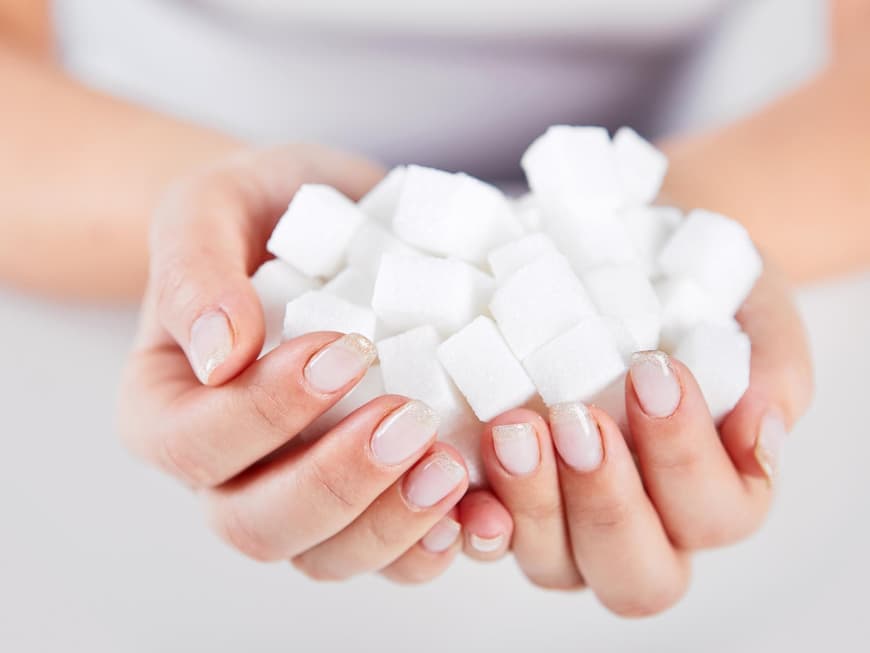
In type 2 diabetes, the body reacts less and less sensitively to the insulin produced in the pancreas. This hormone paves the way for the energy supplier glucose from the blood into the cells. If the body's cells are less responsive to insulin, the hormone can transport less sugar from the blood into the cells. As a result, the blood sugar level gradually rises. In the long term, the large and small arteries and often also the nerves suffer. Consequential diseases include eye and kidney damage, as well as heart attacks
and strokes.
Half of Germans are overweight
But why is there an increase in type 2 diabetes? Our high sugar consumption in Germany plays an important role in this. It can increase the risk in two ways. On the one hand, a lot of sugar in food promotes obesity (especially as sweet foods often contain a lot of fat), and obesity is a recognized diabetes risk factor. Sweets and sweet foods also tempt us to snack. And: studies on soft drinks (sodas, cola drinks) in particular have shown that a high consumption of soft drinks significantly increases the risk of type 2 diabetes.
The sugar industry takes a different view. They point out that the energy balance alone determines whether we gain weight or not. Sugar consumption is not a risk factor for diabetes. "This argument is dubious because it deliberately omits crucial correlations," says Professor Dr. Baptist Gallwitz, President of the German Diabetes Society. Of course, there is nothing wrong with consuming sugar in moderation: "However, the problem is our current diet with a large number of industrially produced foods that contain an excess of sugar, fat and salt and therefore too many calories." And this diet with high-calorie products means that half of Germans are now overweight, which in turn can lead to diabetes and many other diseases. In this respect, there is an urgent need to reduce global sugar consumption, which is far too high.
We underestimate sugar consumption and its consequences
In fact, sugar is omnipresent. Let's assume you start your day with a portion of crunchy chocolate muesli (50 grams) and a strawberry yogurt (125 grams). Then you have already consumed 27.5 grams of sugar. If you then eat a 200 gram portion of diet potato salad at lunchtime, you will have added another 9 grams. If you treat yourself to a cola (0.33 l) in the afternoon, you will consume another 35 grams of sugar. So you would have consumed 81 grams of sugar with these four products alone, without any chocolate or cake.
We usually underestimate our sugar consumption. According to a recent population survey, two thirds of Germans do not know approximately how many grams of sugar they consume per day. On average, we consume 35 kilograms per person per year in Germany. This gives us an average consumption of just under 100 grams per day. This is double the amount recommended by the World Health Organization (WHO), which states that no more than ten percent of our daily energy intake should come from sugar. With an average energy consumption of 2000 kilocalories, that would be 200 kilocalories. This corresponds to 50 grams of sugar.
Reduce sugar consumption - despite tricks of the food industry
But the WHO goes even further and says: "It would be better if we reduced our sugar consumption; only five percent of the energy we consume should come from sugar. In other words, we should only consume 25 grams. That's about five to six level teaspoons. The sugar we consume is not mainly the sugar we stir into our coffee. The problem is the sugar that the food industry adds to its products.
At first glance, it is often barely recognizable. Sugar now has many names - the consumer advice centers have discovered around 60 different ones. The most common names for sugar are Dextrose, invert sugar syrup, sweet whey powder, maltodextrin and glucose syrup. With the many names on the ingredients lists, manufacturers deceive us about the true sugar content and make it difficult for us to reduce our sugar consumption.
Lots of sugar even in white cabbage salad
Another problem is all those savory foods that we don't necessarily expect to contain sugar. We do add a pinch of sugar here and there at home. But a good two teaspoons per 100 grams of coleslaw, as the consumer advice centers discovered on the shelf - that's a lot.
So how can we reduce our sugar consumption? Above all, by preparing a lot ourselves. Instead of crunchy muesli, eat oat flakes and mix them with fruit and low-fat natural yogurt. By looking very carefully at the list of ingredients in ready-made foods. By not being confused by deliberately small portion sizes. By not blindly trusting the advertising claim "less sugar". Due to other ingredients, such products may contain more calories than normal ones. And: Although so-called "light" products generally contain less fat, they are often real sugar bombs!
Reduce sugar consumption: Where we hardly suspect sugar
● Ready-made pizza: The NDR consumer magazine "Markt" discovered at least twice as much sugar in three salami pizzas as stated on the packaging.
● Ready-made salad dressings: Low-fat varieties in particular contain a lot of sugar: There are up to two teaspoons of sugar in two tablespoons of dressing.
● Red cabbage from the jar: 100 grams contains up to 12 sugar cubes.
● Tomato sauce from the jar: Half a portion of ready-made tomato sauce contains up to four teaspoons of sugar.
● According to the Consumer Association of Lower Saxony, barbecue sauces contain between 18 and 48 grams of sugar per 100 milliliters.
